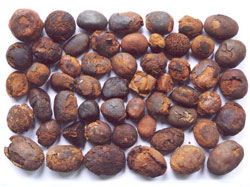Gallstone Disease
 Gallstones disease is characterized by the formation crystalline concretions within the gallbladder (cholelithiasis) as a result of accretion of bile components. Though gallstones are formed within the gallbladder, they can pass into the cystic duct, common bile duct (choledocholithiasis), and even into pancreatic duct. In rare cases, severe inflammation causes the wall of the gallbladder and the small intestine to fuse together and to form a direct passage from gallbladder to small intestine. This can result in a potentially fatal obstruction of the small intestine which is named gallstone ileus.
Gallstones disease is characterized by the formation crystalline concretions within the gallbladder (cholelithiasis) as a result of accretion of bile components. Though gallstones are formed within the gallbladder, they can pass into the cystic duct, common bile duct (choledocholithiasis), and even into pancreatic duct. In rare cases, severe inflammation causes the wall of the gallbladder and the small intestine to fuse together and to form a direct passage from gallbladder to small intestine. This can result in a potentially fatal obstruction of the small intestine which is named gallstone ileus.
When gallstones obstruct the cystic duct, it can result in acute cholecystitis, which is characterized by severe inflammation caused by retention of bile within the gallbladder and pathogenic microorganisms that either got into the gallbladder through the biliary tract or through the bloodstream. Escherichia coli, Enterobacter, or Klebsiella are usually the main causes of secondary infection.
Gallstones can vary in their shape and size, ranging from the size of a grain of sand to the size of a golf ball. The gallbladder can contain either a number of little stones or one large stone. Pseudoliths, which can also cause acute cholecystitis, are not stones, and are often referred to as sludge. Pseudoliths are thick secretions which can obstruct the ducts just like the stones do.
The composition of gallstones can vary from person to person and is affected by the person’s ethnicity, diet, and age. Here are the main types of gallstones:
- Cholesterol stones. These stones have to be at least 80% cholesterol by weight to fall into this category. Their color can range from light yellow to dark brown or green. They can be as large as 2-3 cm in diameter and usually have a dark central spot.
- Pigment stones. Are usually made from calcium salts and bilirubin which are also found in bile. They are usually small and dark in color. Their cholesterol content has to be less than 20%.
- Mixed stones. These stones contain from 20-80% of cholesterol, while the rest is made from palmitate phosphate, calcium carbonate, bilirubin and various other bile pigments. Due to their high calcium content they are usually radiographically visible.
As mentioned above there are two main forms of gallstones disease characterized by various symptoms, diagnosis, and treatment approaches:
